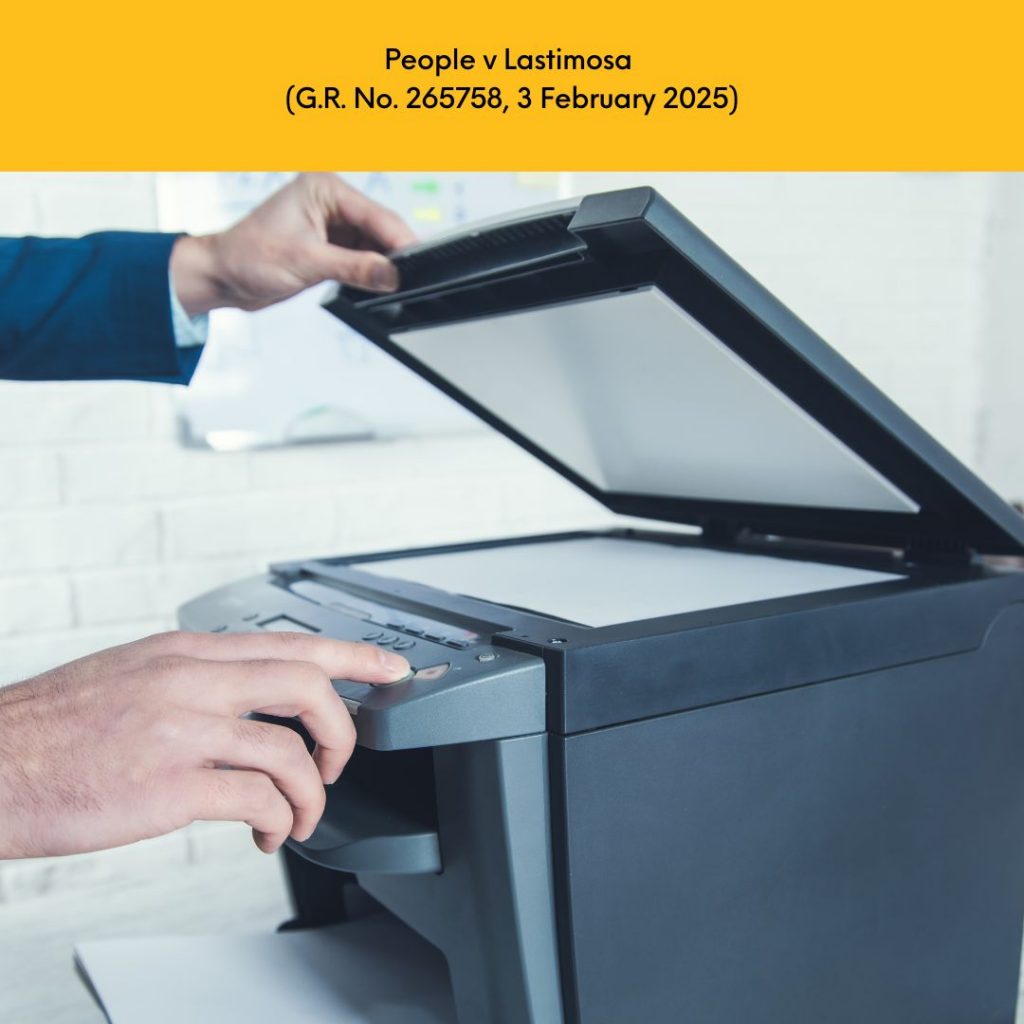
Published 23 May 2025, The Daily Tribune
In a landmark decision issued on February 3, 2025, the Supreme Court ruled that a photocopy is admissible in evidence to the same extent as the original, as long as there is no genuine question about the authenticity of the original or that its admission would be unjust or inequitable.
In People v. Lastimosa (G.R. No. 265758), the Court, through Chief Justice Alexander G. Gesmundo, clarified that under Rule 130, Sections 3 and 4 of the 2019 Revised Rules on Evidence, in conjunction with Rule 4, Sections 1 and 2 of the Rules on Electronic Evidence, a duplicate—whether electronic or paper-based—is admissible like the original unless challenged for authenticity or fairness.
The ruling stemmed from the conviction of Ybo Lastimosa for the 2012 murder of Ildefonso Vega Jr. in Talisay City, Cebu. During trial, the prosecution offered a photocopy of the victim’s death certificate, which the defense opposed for lack of authentication. The trial court admitted it, and the Supreme Court affirmed, stating it qualified as a “duplicate” under the revised Rules.
The Court retraced the evolution of the Best Evidence Rule — from its origins in the 1901 Code of Civil Procedure to the reforms introduced in the 2019 Revised Rules. The revision introduced the “Original Document Rule,” reflecting technological advances and new standards for what constitutes a duplicate.
Rule 130, Section 4 defines a “duplicate” as any counterpart produced by photography, mechanical or electronic recording, or other equivalent techniques that accurately reproduce the original. Subsection (c) provides that duplicates are admissible unless (1) a genuine question is raised on the original’s authenticity, or (2) admitting the duplicate is unjust or inequitable.
The Court noted that this definition mirrors the U.S. Federal Rules of Evidence, signaling a broader shift in favor of modernizing document handling in litigation.
The ruling emphasized that photocopies fall squarely within this revised definition. They are made using processes like photography or electrostatic imaging that faithfully reproduce the original. Thus, photocopies no longer require strict foundation for admissibility unless specifically contested.
This ruling overrules earlier jurisprudence, particularly MCC Industrial Sales Corp. v. Ssangyong Corp. (G.R. No. 170633, 17 October 2007), which had excluded paper-based photocopies from being treated as admissible duplicates under the Rules on Electronic Evidence. Now, all duplicates—electronic or paper—are evaluated on the same footing.
Significantly, although the death certificate in Lastimosa was marked in 2014 — before the 2019 Rules took effect — the Court applied the updated rule retroactively. As a procedural rule, the Rules on Evidence may be applied to pending or unresolved cases unless it impairs vested rights or causes injustice. The Court found no such impediment here.
The decision also reiterates the distinction between admissibility and probative value. While admissibility concerns whether a document may be presented in court, probative value deals with its persuasive strength. In this case, while the photocopy was admitted under Rule 130, Section 4(c), its weight in proving death was bolstered by the victim’s wife’s testimony.
This decision marks a progressive shift in Philippine evidentiary rules. By affirming that photocopies are admissible as duplicates, the Court streamlines judicial processes and removes outdated technicalities that often obstruct the path to justice. It aligns Philippine legal practice with international norms, ensuring that form does not trump substance.
The ruling thus reflects the Supreme Court’s commitment to modern, efficient, and fair litigation practices—where the focus is not on rigid formalities, but on truth, authenticity, and the real merits of a case.
For more of Dean Nilo Divina’s legal tidbits, please visit www.divinalaw.com. For comments and questions, please send an email to cad@divinalaw.com.

